Text
Pitch Idea #1
Why, and how, do people travel for consumer tourism? Where are people coming to New York from, and for what products?
0 notes
Text
Packer Reading: Notes
-Don’t go in cold; do your research before going in. Look at background information, web searching, ask as many people as you can for info.
-If you’re going to a place, history of the place is extremely important
-find a guide. you need help navigating new spaces, and they also can direct you to your most important interviewees
-Come up with guiding question, instead of a precomposed thesis. Know what you want to figure out. Make sure it will lead you down a path
-Capitalize on “outsider status”, helps you to be more observant. Listen!
-Write down fleeting thoughts and speak naturally
-Don’t always post things right away, can often distract you from your thought and process
-Try to limit noise and distractions
-Gather as much as you can on the spot
1 note
·
View note
Text
Event Story: Draft 1
Bartschland Follies: A Night of Performance, Drag, and Fun
(Ledes)
Soft lede - What goes down at the McKittrick Hotel after hours? Lots of craziness, lead by Susanne Bartsch - followed by acts of all sorts.
Hard lede - Why visit the McKittrick hotel after hours on a Friday night? For a show lead by infamous nightlife queen Susanne Bartsch, with performers creating wild moments ranging from strip teases, to pole dances, to opera.
Blind lede - Head to the McKittrick Hotel on a Friday night to see an infamous nightlife queen’s show, full of all sorts of wild acts and an audience willing and ready to participate.
(Story)
What goes down at the famous Manhattan McKittrick Hotel after hours on a Friday night? A show lead by infamous nightlife queen Susanne Bartsch, with performers creating wild moments ranging from strip teases, to pole dances, to opera - and an audience ready and willing to participate.
For the fee of $35 (or $135 for a VIP table, champagne included), anyone can join the nightlife moment that is Bartschland Follies, held in Chelsea at performance space the McKittrick Hotel, home of Sleep No More. Susanne Bartsch returns every show as the host, but the talent included is ever rotating. At the show on the night of March 1st, a wide range of performers had been recruited to make a memorable show.
The show begins with Bartsch and her first MC, Marie, making clever banter on stage and introducing the first act. The first performance is an opera-singing-stripper, causing an excited stir among the audience. Many attendants dressed in leather and lingerie moved among the VIP tables, picking up empty glasses and taking drink orders from the audience as the show progressed. There were many birthday parties seated in the crowd - large, boisterous groups of 10 or more, calling attention to their guest of honor and ordering rounds of drinks.
After the first act concluded, Bartsch and Marie re-entered the stage - making jokes that made some audience members laugh, and others cringe. Tess McMillan, sitting at my table, awkwardly laughed and shook her head at her friend, Jean, as Marie tried to hold the audience’s attention with crude humor and her trademark phrase after every line - “Showbiz, am I right?”
After a few more acts - including three clowns who stripped to complete nudity and a few solo performers dressed in outrageous and unique costumes - Bartsch announced an intermission. With the show beginning at 11:30pm, the intermission at 12:30pm hit after an hour of the show had passed. Following a brief intermission, much of the non-VIP crowd has dissipated, and many of the birthday party attendees had grown much more intoxicated. When the show resumed, Marie was replaced by a new MC - one who drank an audience member’s champagne and even sang opera. One of the performers she announced was Milk, a drag queen made famous by the sixth season of popular show RuPaul’s Drag Race. Many of the audience members recognized her, and cheered as she came on stage wearing a body builder suit, garnished with an American flag leotard.
The night began to wind down around 2am, as the last performer finished and Susanne announced the show was over, and thanked everyone for attending. As we were leaving, Tess, Jean and I discussed the show – Jean said that he enjoyed the performance, though he had mostly attended because he believed Amanda Lepore would be performing. Tess and Jean had met Lepore, another drag queen, at her party the previous weekend and were disappointed not to see her in action at the show. Tess enjoyed the show as well, but we all remarked that we would have had more fun if we had been less tired.
Everyone exited the venue to heavy snowfall, and many hailed cabs, called Ubers, or began to run towards the subway. Many performers stayed outside, speaking with audience members and smoking cigarettes – still in costume. Most of the crowd, the performers, and Susanne Bartsch herself, seemed to end the night in good spirits.
1 note
·
View note
Text
Data Questions
Questions for the data:
-what woman’s hand is considered “average” and from what set was that determined?
-are pants with bigger/better pockets more expensive?
-is this data applicable to non-jeans?
Questions for a human:
-does the percentage of fabrics in each brand of pants change stretchability/pocket size?
-are bigger pockets always considered better, design wise?
-at what point in design history did it become standard for women’s pockets to be smaller in jeans?
0 notes
Text
“Writing a Strong Lead Is Half the Battle” Notes
-lead is often first thing you write to begin giving structure/direction to a piece
-writing lead can illuminate problems and give you a way to see whole piece
-if story is serious don’t use silly/pun lead
-eliminate options before choosing best one
-should not be: cheap, flashy, meticulous, blaring
-“blind leads” withhold information (such as name of subject) aren’t great, often a risk
-leads need to be sound: shouldn’t promise something they can’t deliver; lead is a promise
0 notes
Photo
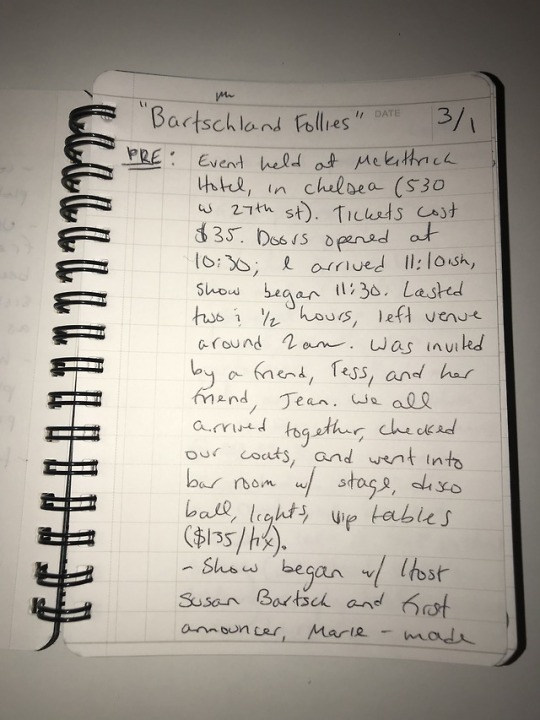

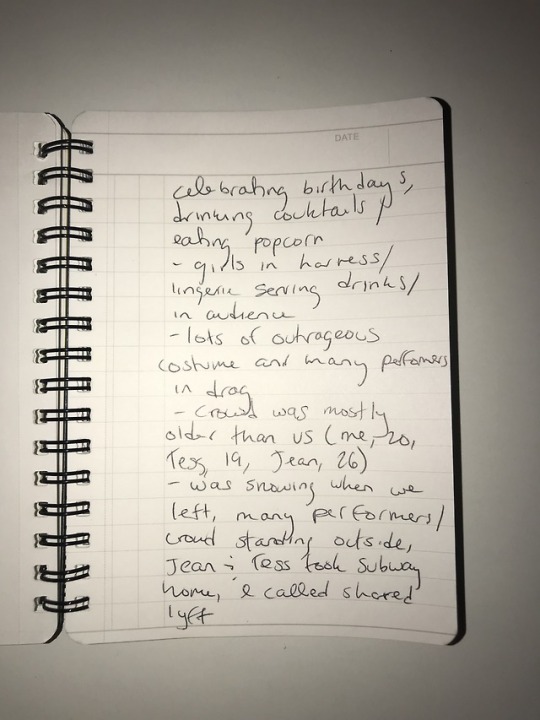
Event Notes - “Bartschland Follies” drag show hosted by Susan Bartsch at the McKittrick Hotel
1 note
·
View note
Text
news&design
https://hyperallergic.com/444883/issues-of-intimacy-distance-and-disavowal-in-writing-about-deana-lawsons-work/
this piece is written on Deana Lawson’s work, and was originally commissioned by Aperture - but due to Lawson’s wishes wasn’t published. The author notes that in his initial caption. All the photos have missing boxes where images should be, they’re only accessible if you click the link below the image box.
0 notes
Text
Draft Re-Edit: Micaela Rebelo
Portuguese Photographer on Life in the Northeast
Micaela Rebelo discusses her current work, family, and growing up in the post 9/11 era in New Jersey.
Micaela Rebelo is the twenty-year-old daughter of two Portuguese immigrants. She grew up in an affluent neighborhood in Warren, New Jersey, with little community besides her Portuguese parents and grandparents. From an early age, she knew she wanted to be in New York City - she moved to New York at the age of eighteen, to pursue an education in Photography at Parsons School of Design. She feels that the city provides her more opportunity to be herself and interact with different types of people: “I like that it’s so diverse,” she says of New York.
Though Micaela found life in Warren to be generally boring, she found that the effect that 9/11 had on so many people’s worldviews was specific to her area. Several people she knew growing up were affected, either by deaths in the family or near death experiences. She feels that 9/11 is a big part of her life and how she was raised - Micaela grew up around the event, and she could feel the effects of chance on people’s families around her. “This one girl, in my cousin's town, her dad didn’t go to work because he had a bad feeling, he didn’t feel well that morning,” she says of one family friend.
Before moving to New York, Micaela was surrounded by her close Portuguese family. Her parents are still married, she has one sister, and her grandparents live nearby as well. Her family travels to Portugal frequently, to visit old friends, and enjoy their hometown, Murtosa. Micaela identifies strongly with being Portuguese, and with visiting her family’s home country. Micaela’s parents actually met for the first time in Murtosa - on the beach, as teenagers. Micaela’s father grew up in Murtosa, while her mother did not (she was raised in America). Her mother was home visiting family, and the couple encountered each other there - but they didn’t start dating until they met again, both enrolled at Rutgers in New Jersey.
The immigration of Micaela’s family to the US was complex and happened over the span of several years. Her grandparents lived in the United States until her uncle died in the Vietnam war - and then the family returned to Murtosa, and her father was born there. When the family decided to return again to the states, her grandfather decided to re-purchased a bar he had owned previously before their move back home. He reopened his business, that business has since been passed on to her father.
Despite her proximity to the city while growing up in Jersey, Micaela’s interest in photography began with photographing those she was close with at home. When asked what subject matter she shoots primarily now, she responds with a giggle, “myself!”. Her self portraits are her main focus now, drawing her attention away from the close family members and friends she used to use as her subjects. She categorizes herself at the moment primarily as a fine art photographer, but she also dabbles into some documentary work. She realized she enjoys shooting film over digital work this year at Parsons, in her core studio class in which she was required to shoot medium format film and craft darkroom prints. After finishing the class, she purchased her own Hasselblad camera and has continued creating self-portraits on film using that camera. She doesn’t have a big preference between color and black and white film, though she does believe some situations require color while others do not - she says the choice “depends on what you’re shooting. Like for documentary, black and white is fine, you don’t always need color, but for fine art, I prefer color.” She enjoys shooting film both because of the physical process it requires and because of the look and feel of her photos. This semester she hasn’t been spending as much time in the darkroom, so she is mostly shooting film because she prefers its aesthetic qualities.
Despite her passion for both photography and New York, Micaela almost ended up in school for education in New Jersey. Her parents met at Rutgers, and they believe it to be an amazing school. They pressured Micaela to enroll at Rutgers for a bit, but once she decided to pursue photography they supported her move to New York. She says if she weren’t in the arts, she would most likely be in training to become a teacher - her family has a large background in education. She has multiple aunts who are school principles and several other family members who teach as well. She actually made the decision to pursue a BFA fairly late compared to most, as a senior in high school. She doesn’t regret her decision - at Parsons, she has been able to discover and foster her love for shooting film, as well as explore the realms of both fine art and documentary photography.
0 notes
Text
http://vestoj.com/are-fashion-designers-made-or-born/
this piece discusses the relationship between class and fashion design in India. The design of the piece and the entirety of the site is very simple and involves few graphics - there are no distractions from the writing. The title caught my attention, and the opinion piece was partly what I was expecting, but put into new context.
1 note
·
View note
Text
Flash Draft: Micaela Rebelo Profile
Micaela Rebelo is the twenty-year-old daughter of two Portuguese immigrants. She grew up in an affluent neighborhood in Warren, New Jersey, with little community besides her Portuguese parents and grandparents. From an early age, she knew she wanted to be in New York City - she moved to New York at the age of eighteen, to pursue an education in Photography at Parsons School of Design. She feels that the city provides her more opportunity to be herself and interact with different types of people: “I like that it’s (New York) so diverse,” she notes when asked what initially drew her to the city.
Though Micaela found life in Warren to be fairly closed off in terms of culture and inclusivity, she is close with her Portuguese family. Her parents are still married, she has one sister, and her grandparents live nearby as well. Her family travels to Portugal frequently, to visit old friends, and enjoy their hometown, Murtosa. Micaela says she identifies strongly with being Portuguese, and with visiting Portugal. Micaela’s parents actually met for the first time in Murtosa - on the beach as teenagers. Micaela’s father grew up in Murtosa, while her mother did not (she was raised in America). Her mother was home visiting family, and the couple encountered each other on the rocks of the beach - but they didn’t start dating until they met again, at Rutgers in New Jersey.
The immigration of Micaela’s family to the US was complicated. Her grandfather lived in the United States until her uncle died in the Vietnam war - and then the family returned to Murtosa, and her father was born there. When they returned to the states, her grandfather re-purchased the bar he had owned previously and reopened his business, that has since been passed on to her father.
Micaela also notes that 9/11 had a big effect on her childhood in New Jersey. Several people she knew growing up were affected, either by deaths in the family or near death experiences. She feels that 9/11 is a big part of her life and how she was raised, which is an experience fairly specific to the area of America that she was raised in.
Despite her passion for both photography and New York, Micaela almost ended up in school for education in New Jersey. Her parents met at Rutgers, and they believe it to be an amazing school. They pressured Micaela to enroll at Rutgers for a bit, but once she decided to pursue photography they supported her move to New York. She says if she weren’t in the arts, she would most likely be in training to become a teacher - her family has a large background in education. She has multiple aunts who are school principles and several other family members who teach as well. She actually made the decision to pursue a BFA fairly late compared to most, as a senior in high school. She doesn’t regret her decision - at Parsons she has been able to discover and foster her love for shooting film, as well as explore the realms of both fine art and documentary photography.
When asked what subject matter she shoots primarily, she responds with a giggle, “myself!”. Her self portraits are her main focus now, drawing her attention away from the close family members and friends she used to use as her subjects. She categorizes herself at the moment primarily as a fine art photographer, but she also dabbles into some documentary work. She realized she enjoys shooting film over digital work this year at Parsons, in her core studio class in which she was required to shoot medium format film and craft darkroom prints. After finishing the class, she purchased her own Hasselblad camera and has continued creating self-portraits on film using that camera. She doesn’t have a big preference between color and black and white film, though she does believe some situations require color while others do not - she says the choice “depends on what you’re shooting. Like for documentary, black and white is fine, you don’t always need color, but for fine art, I prefer color.” She enjoys shooting film both because of the physical process it requires and because of the look and feel of her photos. This semester she hasn’t been spending as much time in the darkroom, so she is mostly shooting film because she prefers its aesthetic qualities.
0 notes
Text
Transcript: Interview with Micaela
Red: Quotes-- your favorites (threads to build your piece) there wasn't an orange highlighter option!
Yellow: Clarity (I’m confused, help me out)
Green: Follow-ups (I’m curious, tell me more!)
Pink: Facts (how do we know this? Source? too good to be true - ie, fact-checking needed)
Blue: Observation (what is the person wearing, how is she talking? how does she walk? etc)
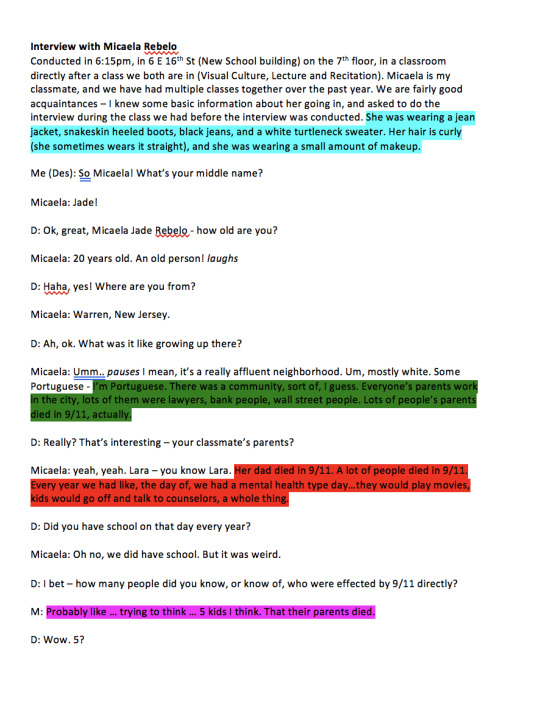
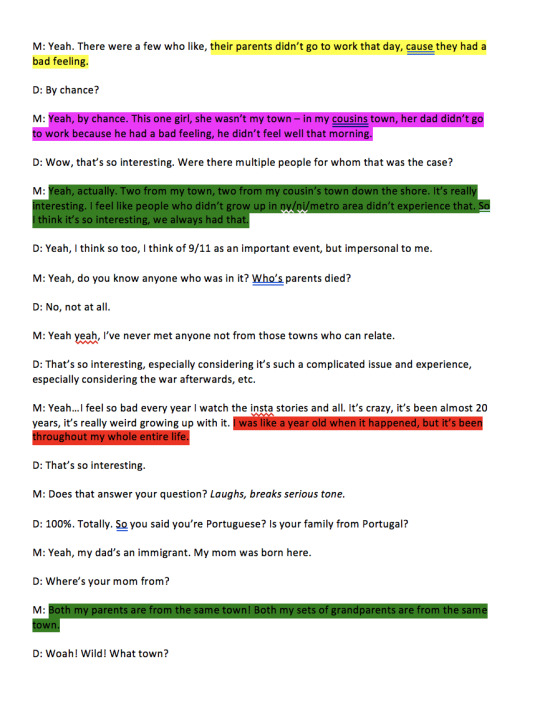





0 notes
Text
Interview Notes

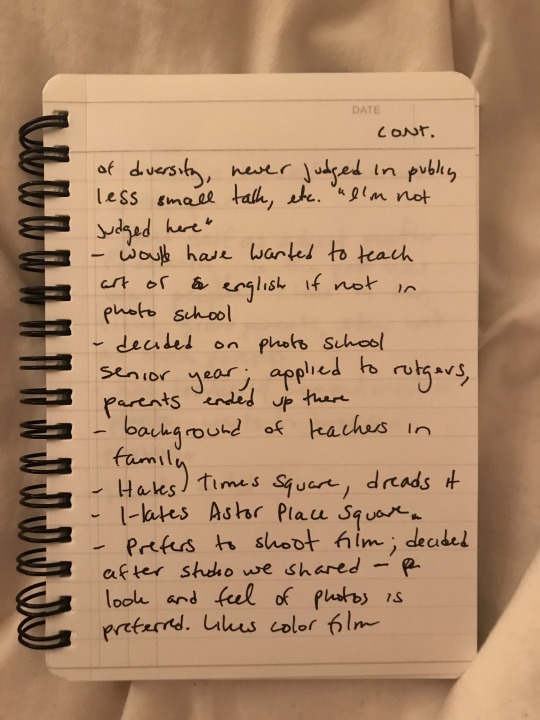

potential interview questions (brainstormed before):
-age, name
-where are you from?
-what was it like growing up there?
-why do you live in new york?
-do you prefer (home city) or new york?
-what area do you live in?
-what is your least favorite place in new york?*
-what are you studying and how did you decide on that field of study?
-do you have a job? (if no) what was your most recent job?
-do you prefer to shoot film or digital*
-if you weren’t in school for photo, what would you be doing?
-crazy roommates?
0 notes
Text
https://www.nytimes.com/2019/02/07/fashion/kerby-jean-raymond-pyer-moss-not-showing.html
article about Pyer Moss’ decision not to participate in nyfw - title is dramatic and interesting and draws the reader into story. Story is interesting and delves into history of Pyer Moss’ work and the fashion history surrounding it & goes into theories about his strategy
0 notes
Text
Washington Sq Park Interviews

arrived: 11:30
left: 11:45
0 notes
Text
Tyler’s Map - story ideas
Story #1 - About fountain; when does it turn off and how does it affect the iconic feel/look of the park? Who hangs out in there
Story #2 - Monuments & geography - who are the streets and monuments surrounding the park named after and why? how does the geography of the park affect the population of people there?
0 notes
Text
reading reflection
I found both readings interesting - particular concepts that interested me were the difference defined by the author between artist and designer, the idea of too much function making machines difficult for humans to manage, signifiers and how humans need feedback to be satisfied with designs.
The difference between artist and designer has always interested me as many people identify as both, or sometimes categorize themselves dependent on the project. I have always seen design as a more technically applied and more well-rounded type of art thinking - design incorporates many aspects and elements of a concept, where art is sometimes only concerned with the aesthetics and conceptual meaning. This piece seemed to define that difference well.
In the second piece, I was interested in how machines depend on discoverability and understanding to function, and how too much function causes humans to be overwhelmed by machines and get frustrated. I was thinking about this in my own experience and found it true. What came to mind was Ikea design - in how instructions, steps, and aesthetic tend to be simple and minimal to tend to humans need for less complication. In addition, I was considering the author’s point about feedback being necessary for humans to be satisfied in their interactions with machines. I also find this true in my own life (for instance - in the Parsons building where my classes are, the elevator button doesn’t light up, and people press it over and over, glaring at those in front of them in line, assuming they hadn’t already pressed it. I follow the cycle, despite knowing the drill and having had class there for a year and a half).
I also found the concept of signifiers in machines interesting. In a class last year we discussed signs, signifiers, and signified deeply, and it caused me to think of machine circuits - such as how a light switch signifies the light coming on in a room, despite that we can’t see that process happening it is assumed in function. I was also interested in the point about how designers must understand both technology and psychology. This is definitely true - good machines, systems, and aesthetics can’t be built without a deeper sense of how humans tend to function.
0 notes
